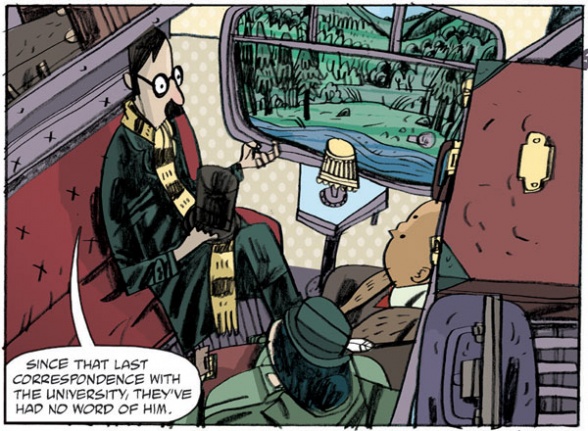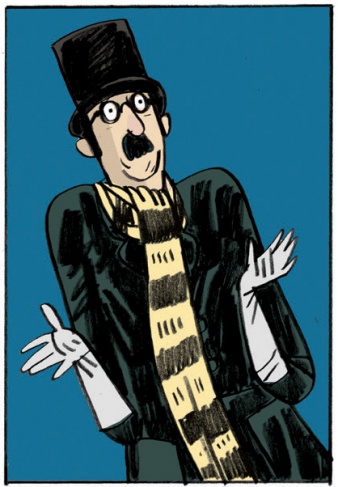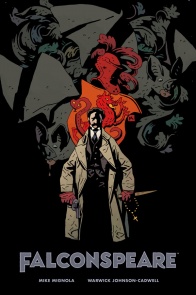
Warwick Johnson-Cadwell and Mike Mignola’s “The Adventures of Professor J.T. Meinhardt and His Assistant Mr. Knox” series continues with its third volume, “Falconspeare.” But if you’re expecting more of the same, “Falconspeare” delivers something even better.
This review contains spoilers, including some discussion about the ending.
Cover by Mike Mignola
with colors by Dave Stewart
Created by Mike Mignola and Warwick Johnson-Cadwell
Written and illustrated by Warwick Johnson-Cadwell
Lettered by Clem RobinsJump into an eerie Victorian-style mystery with an off-kilter, charming twist in the next knockout collaboration from Mike Mignola and Warwick Johnson-Cadwell! Monster hunters extraordinaire Professor Meinhardt, Mr. Knox, and Ms. Van Sloan have teamed up to slay spooks and investigate the uncanny before, but now they’ll tackle a question that’s haunted them for years: What happened to their friend and vampire slayer extraordinaire, James Falconspeare?
Rendered in Johnson-Cadwell’s signature loose, expressive style, and with gorgeous cover from Mignola and colorist Dave Stewart, this hardcover will be a treat for fans of Mr. Higgins Comes Home and Our Encounters with Evil as well as folks new to the world Johnson-Cadwell and Mignola have created.
Mark: “Falconspeare” is the third book in “The Adventures of Professor J.T. Meinhardt and His Assistant Mr. Knox” series. It could have very easily settled into the familiar and told another adventure in the vein of its predecessors. Instead, “Falconspeare” shakes things up a bit, telling a more somber story. Not that there weren’t somber moments in past stories, but they were moments in a larger story, whereas in “Falconspeare” the somber mood hangs over everything. It is its defining quality. The humor is still there, but it’s not the focus and there are stretches built almost entirely around atmosphere.
More than anything, it’s felt in the pacing. I mentioned back in our “Mr. Higgins Comes Home” review how Warwick Johnson-Cadwell’s work can feel like a carriage bouncing all over the road. In “Falconspeare,” the carriage has slowed down, ominously shuddering with each bump on the way. It is still recognizably the same series, but it’s traveling new roads, striking out into new territory.
Brian: In the dedication to “Mr. Higgins Comes Home,” Mike Mignola mentions the Hammer Films series of vampire movies as inspiration, and that has been the defining visual language of this series, up to and including “Falconspeare.” But this book, as you noted, has a very different cadence than the other two stories, both of which whipped through action at a frenzied pace.
“Our Encounters With Evil,” being a collection of stories, took that frenzy to a new level, with no time for reflection at all. I really enjoyed that collection, but this returns to some of the heart of “Higgins” while adding a lot of new dimensions to the work. Slowing it down and giving more time to the Meinhardt’s crew, instead of focusing on the supernatural creatures they are hunting, allowed Johnson-Cadwell to both tell a new story and build up the characters and their world considerably.
I want to talk about the opening sequence, which details an earlier adventure with this crew, and ends with Meinhardt declaring “Well, we’re getting better at this.” That sequence was everything we’d come to expect from the series, in terms of your well coined ‘bouncing carriage’ metaphor. That sequence, and specifically that phrase, comes very much into play at the end of the story, and acts as a little teaser for how the tale will play out. I found that particularly clever bit of writing from Johnson-Cadwell, who is impressing more and more with each volume.
Mark: I have to agree. He’s toying with our expectations in the best possible way, setting us up for more of the frenzied action of “Our Encounters with Evil,” only to go a very different direction with it. Ironically, going a different direction brings the story right back to the beginning. There’s a wonderful inevitability to the tale, so much so that I found reading it again and knowing exactly what was going to happen made me enjoy it more than the first time.
Admittedly, on my first read through, the material immediately following opening felt almost too subdued. We saw the characters blow up a vampire’s head with a stick of dynamite, and then we settle into a scene with the characters chatting ominously over tea and maps. And it continues on like that for a while, focusing more on the atmosphere and the quirks of the characters. On my second read through, I was much more present in these scenes, slowing down and enjoying what they were doing instead of rushing through them to get to the next big set piece. And considering that this is a hardcover graphic novel, something you’ll presumably want to read more than once, I see this as a major plus. I tend to love stories where the first and second readings are notably different.
Continued belowBrian: My wife often teases me for liking books and films where nothing happens, so I was quite content to sit and hang out with these characters for a bit and enjoy their conversations without too much action. But beyond that, I felt that after the whirlwind of “Encounters,” it made sense to give us a bit of a breather, as well as an opportunity to get to know these characters a little more. I know that these stories are never going to be character studies or quiet meditations on their motivations and internal longings, but I quite appreciated the slower pace for a few pages.
While we met Ms. Van Sloan in “Encounters,” it was nice to have another character accompanying our friends Knox and Meinhardt. What did you think of her full-time addition to the team?
Mark: She’s an absolute must. She shakes things up with Meinhardt and Knox, especially since unlike Knox, she’s not subservient to Meinhardt. She’s a paranormal adventurer in her own right, and as we saw in “Our Encounters with Evil,” she’s free to come and go as she pleases too. In “Falconspeare,” she’s probably the most active in trying to find their old friend, closely followed by Knox. Meinhardt, who in previous stories was usually the one that decided what to do next, mainly follows in this one. That’s the sort of effect Ms. Van Sloan has—she flips the usual dynamic.
With the focus of this story on James Falconspeare, it wasn’t the place to explore that dynamic further, but it certainly could be explored in future volumes, so I hope Mary Van Sloan will stick around for more.
How did you find Johnson-Cadwell’s art “Falconspeare?” I’ve always enjoyed the way he moves the “camera” through a scene, but here, perhaps because he had to slow things down more and because the characters were often in confined environments, I felt he pushed that aspect of his work further.

You mentioned the Hammer Films earlier, and I’m feeling that influence in panel composition even more than in the previous volumes.
Brian: I could see that, though the aspect that jumped out most to me was the body language of these characters. Now that Johnson-Cadwell has drawn them for almost 200-ish pages, he has really gotten inside of them in a way that wasn’t present in the first two volumes. That’s not a knock on his past work, but rather a celebration of his current status quo.
Because of that knowledge, he’s able to have them do things that, on the surface, may not seem like a natural action or position, but they look totally natural doing it, such as Meinhardt’s shrug, which I want to adopt as my social media avatar:

This also allows his humor to seep through a little more in the visuals, even if this is easily the least playful of any of the volumes, due to the personal relationship between Falconspeare and the rest. Perhaps because of the dire situation at the center of the story, Johnson-Cadwell felt he needed more humor to keep the book balanced.
Mark: Oh, yes, I absolutely agree there. It’s everywhere in the way the characters simply respond to others. Like early on in the story, Meinhardt’s butler seems absolutely furious that he has to be a butler—and that stuff works great, but what elevates it for me is the little responses to this in the other characters.

Knox’s face in particular is perfect.
I also wanted to touch on Johnson-Cadwell’s colors too. It should come as no surprise that scenes with vampires and murder and flooded with red, but given how overblown the opening sequence is, it is surprisingly restrained in this regard. In contrast with the final scene, where the red is all encompassing. But the red is tied to more than just vampires. The walls of the Fontin manor are also red—again, not surprising given to the association of murder with the location, but I think it’s more significant in the change it brings about in Falconspeare. I feel like red is more closely associated with his turmoil.
Continued belowBrian: Not to hammer (pardon the pun) home the Hammer connection too much, but in Hammer films, there were two distinct reds: a dark, almost maroon red, and then the shocking, almost pink blood. Johnson-Cadwell continues that by making all the blood a clearly different hue. But you’re right, turmoil is red here, but blood is red.
The other question I wanted to ask you was one of future stories. Do you think that the stories will continue to progress in a linear fashion, or do you think we’ll see a book of the adventures of ‘young’ Meinhardt, like the first sequence in this book?
Mark: Honestly, it’s wide open. I even like that the next one doesn’t even have to be a single story, but could be a collection of short stories again. Or perhaps some other kind of surprise. I follow Warwick Johnson-Cadwell on Twitter and, I swear, any one of the pictures he posts could easily become a full story. One week he posts pirates, and immediately my brain starts conjuring up stories of Meinhardt, Knox, and Van Sloan on the high seas. Oh, a ghost ship could be fun…
“Falconspeare” ended up not being entirely what I expected, and that’s a very good thing. And it makes me excited for whatever’s next. Not knowing what that is or even what form it could take just adds to my anticipation. So I suppose we should get to grading. I’m going to give this a 9. How about you, Brian?
Brian: I thoroughly enjoyed this, and am glad it is the first book I finished in 2022. I am glad that Johnson-Cadwell has continued these characters’ adventures, and I am hopeful that he continues to do so. This is a 9.0 for me.
Final Verdict: 9 – “Falconspeare” is another fun and surprising chapter of the Meinhardt and Knox saga from Warwick Johnson-Cadwell.







